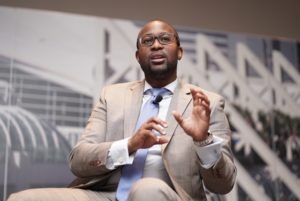Dr. Nicholas Pearce has a resume matched by few. A scholar, speaker, entrepreneur, and pastor, Pearce also has a passion when it comes to workplace matters, specifically when it comes to his presented session, “A Fireplace Chat on Diversity, Equity & Inclusion.”
In a session moderated by Diversity & Inclusive Leadership Committee member Naz Sabripour, Dr. Pearce touched deeply on a number topics that, well, happen to be uncomfortable for many.
Pearce began by touching on the subject of work/life balance, a topic he says he that he pushes back against.
“It suggests you try to balance the two,” Pearce said. “A significant part of your life  involves work. Think about life being integrated well with all parts of our lives being able to intersect.”
involves work. Think about life being integrated well with all parts of our lives being able to intersect.”
That said, what happens next in the workplace where one spends so much time?
“People think of diversity and inclusivity as a nice to have bonus, but to achieve goals it has to be inclusive of people in the community. The workforce of today is not the workforce of tomorrow.”
“You have more diverse people living in smaller spaces,” he noted.
Pearce next spoke about the comfort level that comes when teams operate homogenously. To coin another phrase, Pearce called it the “sea of sameness.” “This is when everybody around the table will feel good about themselves,” he said. “It feels good to have people agree with you. It’s the notion of the classic management idea that the best meeting is a fast meeting.
“Diversity is not a code word for minorities, but for human differences of all kinds. Leaders have to realize there is a trade-off between effectiveness and efficiency. Diversity makes us work harder and turn brains on a higher mode. You’re asking more questions and listen more differently.”
Pearce also noted that diversity and inclusion are used interchangeably, an error often unchecked.
“Diversity is about human difference of all kinds … race, disability status, or something deeper such as thought beliefs or social networks. Diversity is about counting the heads in the workplace but inclusion is making the heads count. You can have an organization very diverse but not very inclusive.”
The conversation next turned to equity. “If I am at the table, do I have an equal shot?” Pearce asked. “Does everyone have a level playing field?”
Pearce then made a comment that gave serious pause for consideration. To wit: organizations can create numbers that show they are “diverse” or “inclusive” when in reality the numbers can be manipulated. Or, as Pearce so succinctly said, “You can tell more lies on Excel than on Microsoft Word.”
“Equity is not a one-and-done decision,” he said. “It is a way of life. By 2043, the majority of the U.S. population will be people of color.”
Pearce concluded the fireside chat (which hopefully got a little too warm for some folks) by asking how an inclusive culture is created.
“It rises and falls on leadership,” he said. “Culture change is always to-down and has to be sustained through hiring. Do I hire the best talent or a diverse person? My answer is yes. It’s not either/or. When you are under pressure it reveals who you are anyway.”
